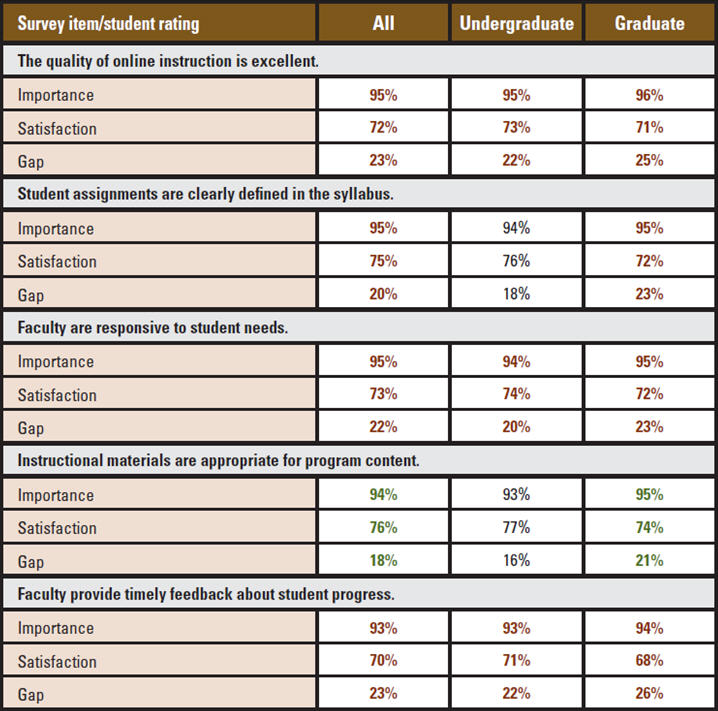enrollment
The satisfaction and priorities of online college learners
Are online students satisfied with instruction?
As we discussed in a previous blog, faculty interactions are a pivotal point of the college student academic experience. This is true for students in online courses as well. The quality of instruction, clearly defined assignments and faculty responsiveness are three key elements that influence student perceptions about the academic quality of their online experience. So how do online learners nationally rate their experience with faculty?
The 2014-2015 National Online Learners Priorities Report provides insight to student perceptions in this area. The report reflects responses from more than 122,000 college students enrolled in undergraduate and graduate online courses between the fall of 2011 and the spring of 2014. The tables below show three key ratings that illustrate student perceptions on the instruction they receive:
- Importance: The percentage of online learners who said that an issue was important to them.
- Satisfaction: The percentage of students who were satisfied with that issue,
- Gap: The difference between the importance and satisfaction scores. Higher gap scores indicate that students are not as satisfied on issues of high importance.
On instruction-related items, online learners had high gap scores on four out of five key issues:

Two of these issues, faculty being responsive and faculty providing timely feedback, while also important to students in traditional programs, take on an even greater priority for students in online courses. The nature of the 24/7 online learning environment may create an expectation of constant availability of faculty. It is important for online faculty to communicate guidelines on what students can expect for responsiveness, and then stick to those promised timeframes.
The perception of the quality of instruction is a challenge item (high importance, large performance gap) and a priority for improvement. Note that while 72 percent of students did indicate that they were satisfied or very satisfied in this area, the 95 percent of students who labeled it important creates a gap of 23 percent, which is why it is a challenge. Online learning institutions have opportunities to influence perceptions of the quality of instruction through their marketing and orientation efforts, as well as with appropriate training of their online faculty.
The priority of tuition paid being a worthwhile investment is an issue for online learners as well as traditional students.

However, while the perception of tuition value is a challenge for online learners, they had considerably higher levels of satisfaction than students at four-year institutions on this item, where satisfaction ranged from 46-52 percent. (See the 2014 National Student Satisfaction and Priorities Report for more details on student satisfaction among traditional college students).
Download the 2014-2015 National Online Learners Priorities Report to see more satisfaction and priorities responses on issues such as enrollment services, academic services and student services. The full report also includes a list of the top factors influencing online learners’ decisions to enroll in their program.
You can also learn more about the survey instrument used for the report, the Priorities Survey for Online Learners. And as always, I am happy to answer any of your questions too. Just send me an email or connect with me on Twitter.

